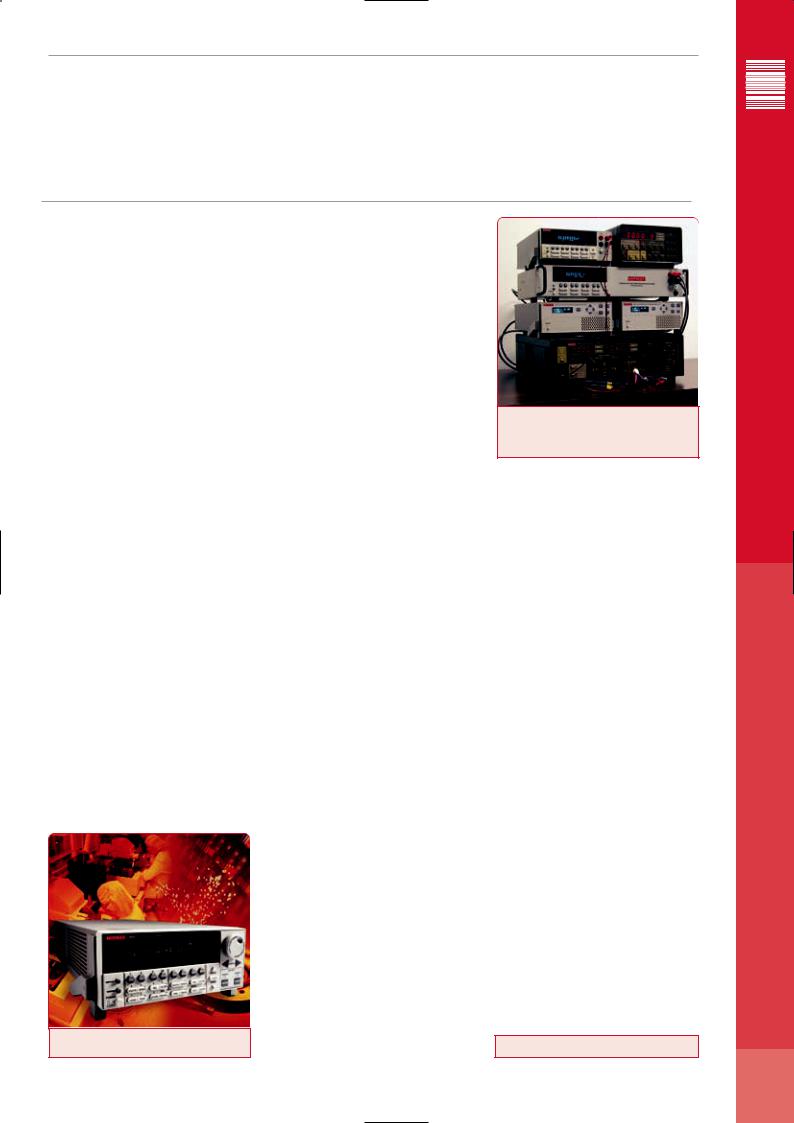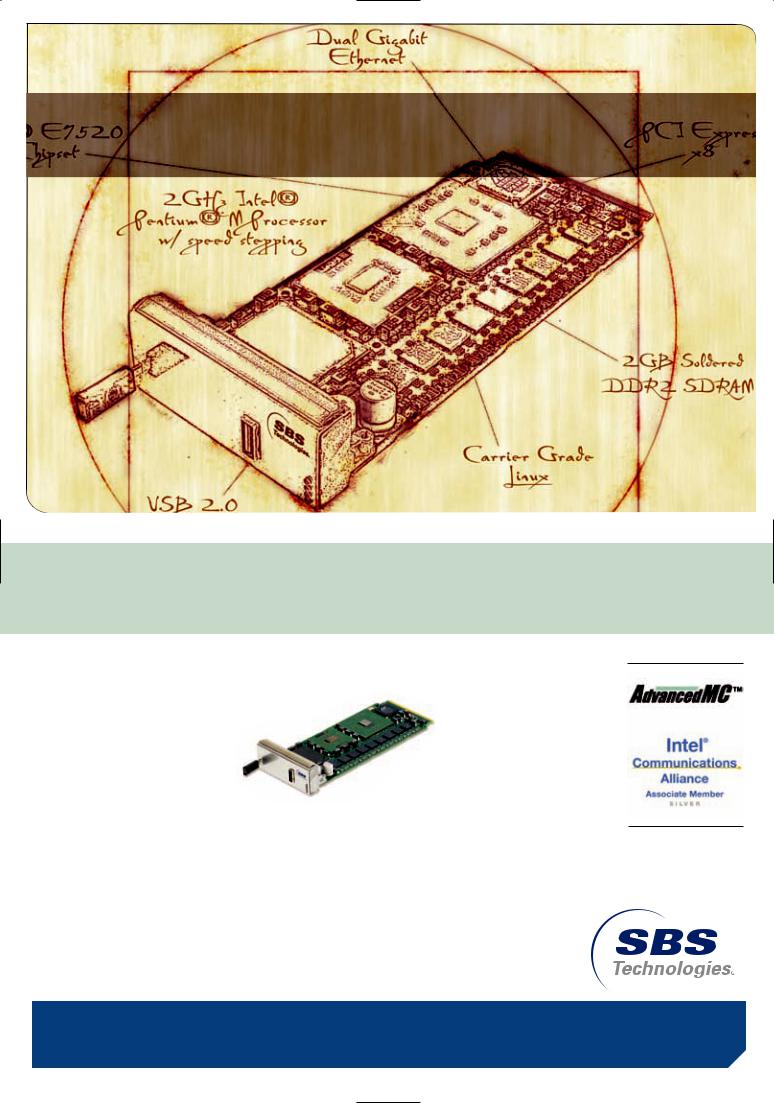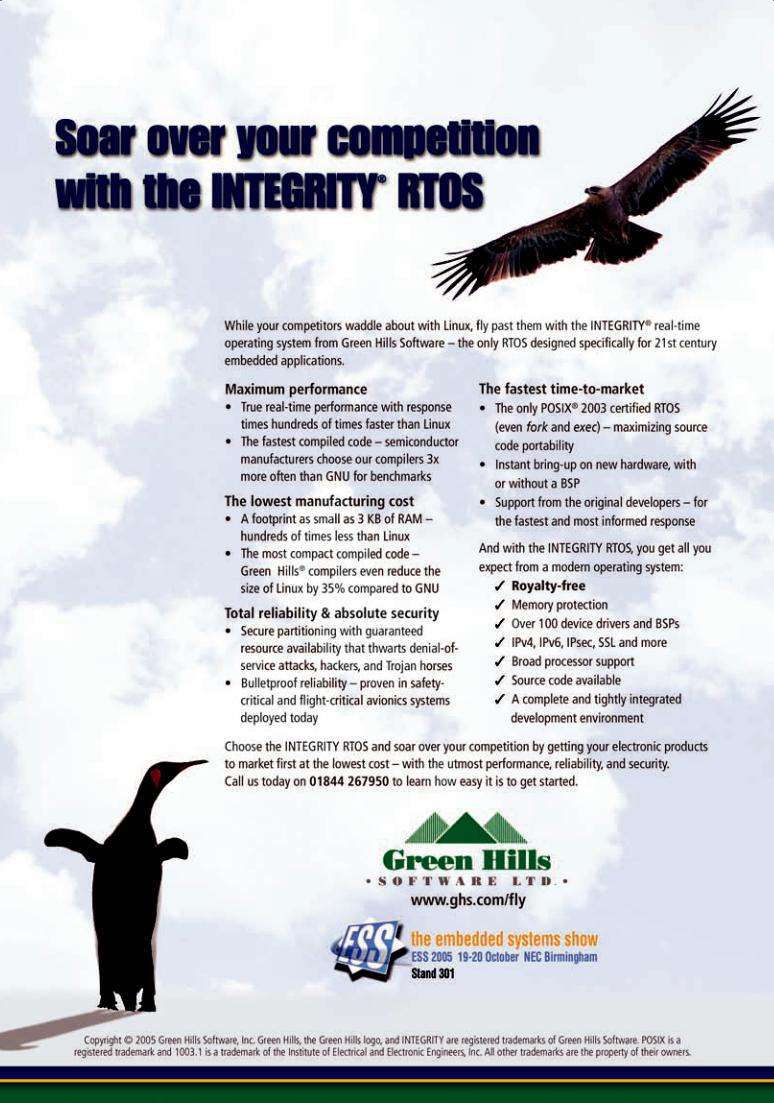
Embedded system engineering magazine 2005.09
.pdf
</Feature>
ESE Magazine September 05
Synthetic Instruments
<Written by> John Stratton, Agilent Technologies </W>
The new LXI interconnection standard offers a compromise between cost, performance, size, and product life for instrumentation.
HE CONCEPT OF synthetic instru- |
automotive industries where longer life cycle |
|
arises from the requirement of the |
support and smaller form factor is a require- |
|
aerospace/defence industry |
for more |
ment. |
Teffective, compact, high |
precision, |
The VME computer backplane was eventual- |
Plugfest
The LXI Consortium held its second PlugFest on Aug. 23-25. The aim was to test the LXI standards as implemented by consortium members. Prototype products from Aeroflex, Agilent Technologies, Keithley, MCC, Pickering, Rohde & Schwarz, Venture, and VXI Technology were tested to different areas of the specification, including LAN functionality, Web interface compliance, hardware trigger, programming API, and IEEE 1588 protocol implementation. It was attended by 45 members of the LXI Consortium.
Driving down the total cost of ownership of automatic test careful consideration of what role the functional
sis uses a down-converter module coupled to an IF digitiser linked to signal analysis software. Modules can be re-configured to fit a multitude of test functionality.
Key is the unbundling of hardware and software into functional elements and the provision of a connectivity environment that supports the inter-working of these. Advances in the development of automatic test systems (ATS) dictate that this connectivity environment will be driven by computer industry standards.
Computer standards
Since the development of the personal computer the trend is to replace expensive proprietary computers and computer operating systems with open platforms for ATS for the best price- versus-performance.
This, in turn, has created new interconnection standards. The partially adopted VME/VXI architectural design reduced the cost and increased the reliability of sophisticated ATS. However, the relatively small sales volume of the VXI hardware and the cost of redesign caused manufacturers to charge more than their fully integrated instruments, even though there was no display, computer, or power supply. Despite this apparent contradiction VXI met with moderate success in the aerospace/defence and
has developed a bridging strategy while the industry converts. Some logical questions might be, how long will PCI Express be around? And will we make the same mistake again?
Next generation standards
For the success of synthetic instruments (with both reusable hardware and open software) the test industry must agree upon standards, including interconnection standards.
Without these the internal PC interfaces could cause churn in ATS hardware. While no interface standard lasts forever, LAN (Ethernet), as a communication medium, promises to be the standard that will be around the longest. Introduced in 1985 (IEEE 802.3a) operating at 10 Mbits per second by 2002 it had increased in bandwidth to support 10Gbits per second (IEEE 802.3ae), three orders of magnitude improvement in 17 years. Additionally, LAN comes as standard in most PCs and is one of the lowest cost interfaces to implement in instruments.
But LAN is non-deterministic. How can it can provide the inter-module synchronization required by some test applications? Most of these issues can be addressed with the new IEEE 1588 (Precision Clock Synchronization Protocol for Networked Measurement and Control Systems) standard introduced in 2002,
40

The test bench today
<Written by> Dale Cigoy, Keithley Instruments, Inc. </W>
The classic test bench can be simplified yet still cope with complex hardware.
ATYPICAL TEST-BENCH consists of a number of instruments including voltmeters, current meters, ohmmeters, voltage and/or current sources, and
frequency generators. Photos of a test set-up often show rows of boxes stacked several feet high with a maze of wires, cords, and test leads curling around the benchtop. However, newer generations of instruments combine many, if not most, of the functions found in stand-alone instruments into one box.
New instruments
The biggest and most notable change in the design and manufacture of newer generations of
interfaces for testing newly emerging serial buses. On the other hand, some cutting-edge applications demand entirely new tools and features. The field of nanotechnology research and development demands instruments that can measure extremely small quantities in the range of nanovolts and below, accurately and repeatedly. Nanotechnology research also demands highly accurate and stable sources of arbitrary waveforms. Many instruments can now offer the precise and stable waveforms necessary for nanotechnology applications.
New interfaces
The growth of the Internet and the World Wide Web has also impacted test instruments. Webenabled instruments are fairly common today. Most of these instruments contain an Ethernet connection that lets the instrument talk to a PC or connect to other instruments to form a complete data-acquisition system.
Another advance in interfaces comes later this year with the LAN extensions for instrumentation (LXI) through the work of the LXI Consortium. Basically, LXI is an Ethernet-based communications standard for small, modular instruments with or without front panel control or on board display. LXI instruments are designed to operate with Ethernet as the system communications backbone. The Consortium’s goal is to define a common instrumentation standard to offer flexible packaging and tight integration advantages of proprietary modular instruments without the physical constraints and added cost of card-cage architectures.
As for other communication interfaces, IEEE488 or GPIB is still a dominant network, partly because it has been around for nearly three
Figure 2: Many instruments on a test bench or one instrument with all of the capability of the others built in.
Figure 1: Series 2600 SourceMeter Instrument. |
More and more instruments now come |
www.keithley.com |
|
equipped with software so that users can |
|||
|
|||
|
|
</Feature>
ESE Magazine September 05
41

</Feature>
ESE Magazine September 05
Reliable file systems
<Written by> Michael McPherson, Datalight </W>
How can you save all system data in the event of an unexpected system crash or power outage?
IN EMBEDDED applications, unexpected power interruptions are quite common. From harsh environmental conditions degrading product performance to the point of failure, to simple accidents
like batteries popping out when a device is dropped, embedded devices generally aren’t treated with the same reverence as a desktop computer.
However, the data stored on the device may be much more valuable to the user than the data stored on their PC. It could be global positioning data for a military operation, performance data logged over weeks on a production line, or even the first Wallace and Gromit film on your home PVR. Furthermore, unlike a desk-
There are a few simple tests you can run to determine whether your file system is at risk of producing a disastrous crash:
Step one is to ensure that your file system is operating correctly in the first place.
(1)Validate that all APIs and system calls are handled properly
(2)Next check your boundary conditions; fill the disk and find out what happens when you try to write something that you don’t have room for, or barely have room for, to make sure that the file system handles this properly.
(3)You need to ensure that the file system is “playing nicely” with the filters that may be built-in to the layers between the file system
tories deep and a power interruption occurs while attempting to overwrite a directory in the middle, file systems will often fail horribly; data loss will occur. Power interruptions can also be quite destructive when changing file attributes.
(3) Removable media: Pull a flash card or a USB reader as data while writing to the device. Obviously, the last file will be gone, but the true test is whether or not the file system is still intact.
If the data stored by your file system withstands these unexpected crises by booting cleanly and restoring all your files intact – bravo! If, however, you find corrupted files or
How do you know whether you need a reliable file system? You must consider the value of the data stored on the device and the impact of data loss. If the device is measuring the flow of fuel through a pipeline, it’s important that a week’s worth of data not be lost if power spikes and the recorder shuts down.
or brand with a terrible reputation for quality. |
that if you make a directory tree several direc- |
|
|
42

SBS knows Modular Computing.
Careful design yields speed & thermal effciency.
BY CLEVERLY INTEGRATING best-of-breed silicon, SBS Technologies® has created a processor AdvancedMC™ that fully exploits the
this new form factor. Think of it as AdvancedMC Extreme. There’s extreme bandwidth: parallel PCI Express® x8 lanes, dual Gigabit Ether-
net links, and two SATA channels to the carrier. Extreme processing power: the latest 2GHz embedded Intel® Pentium®M processor with 2 MB integrated L2 cache and a 533 MHz
front side bus. Extreme silicon: DDR2 - 400 MHz SDRAM, the Intel® E7520 chipset with 533 MHz system bus to the processor, plus one PCI Express x4 bus with 2Gbytes/s rate to Ethernet and another x8 bus with 4 Gbytes/s transfer
rate to the AdvancedMC interconnect.
The new Telum® ASLP10 processor AdvancedMC from SBS Technologies. Beautiful, isn’t it?
For SBS Technologies in the UK please contact John Vaines, Country Manager UK,
Tel: +44 (0)1634 256 953
SBS Technologies GmbH & Co.KG Memminger Str. 14
86159 Augsburg
Tel: +49 (0)821 5034 0 Fax: +49 (0)821 5034 119 aug-info@sbs.com
MORE OPTIONS. MORE INSIGHT. MORE INTELLIGENCE.
Find the processor AMC board you’re looking for right now at: www.sbs.com/amc
Please order our new catalogue.
All trademarks and logos are the property of their respective owners.

